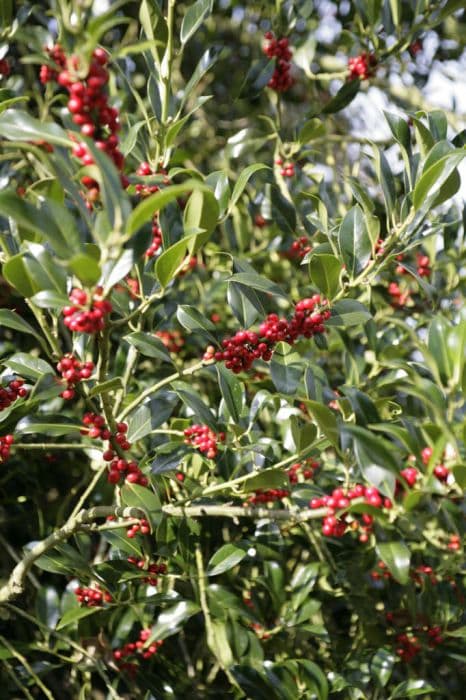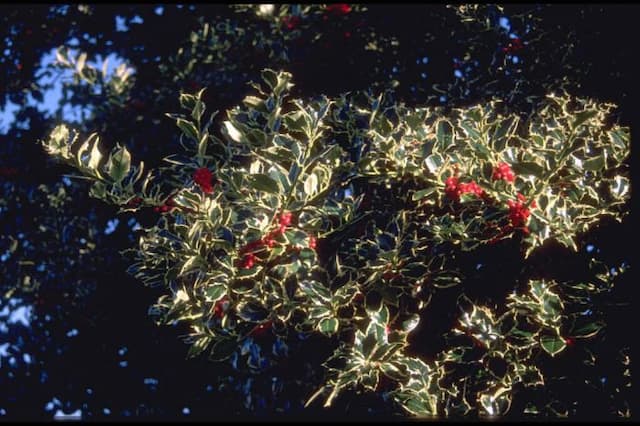Japanese holly Ilex crenata 'Shiro-fukurin' (f/v)

ABOUT
Ilex crenata 'Shiro-fukurin', commonly known as Japanese Holly, is characterized by its distinctive foliage and overall look. The leaves of this cultivar are small, glossy, and oval-shaped with a slightly waved appearance along the edges, giving it a delicate texture. A defining feature of the 'Shiro-fukurin' variety is the variegation on the leaves – they are edged with a creamy white or yellowish margin that contrasts sharply with the deep green center. This variegation can make the plant quite striking in the landscape. The Japanese Holly may produce inconspicuous white flowers in the spring, which are followed by small, black berries if pollinators are present, and a male plant is nearby. The overall form of the plant is dense and compact, with a mounding growth habit that lends itself well to hedging and topiary. The branches are fine and may develop a slightly zig-zag pattern, adding further interest to this plant's structure. The appearance of the 'Shiro-fukurin' Japanese Holly provides a year-round interest due to its evergreen nature, meaning it retains its leaves throughout all seasons. Its variegated foliage is particularly valuable in adding light and pattern to shaded areas in a garden setting.
About this plant
 Names
NamesFamily
Aquifoliaceae
Synonyms
Japanese Holly, Box-leaved Holly, Variegated Japanese Holly
Common names
Ilex crenata f. leucocarpa, Ilex crenata 'Albovariegata'
 Toxicity
ToxicityTo humans
Japanese holly is considered toxic if ingested due to the presence of saponins. Consumption can cause gastrointestinal upset, including symptoms such as nausea, vomiting, and diarrhea. More severe symptoms may include dizziness. Ingesting large quantities can be more dangerous and warrant medical attention.
To pets
Japanese holly is also toxic to pets, including cats and dogs. The ingestion of leaves or berries can lead to similar symptoms as in humans, such as vomiting, diarrhea, and depression. If a pet consumes a significant amount, it is important to seek veterinary care.
 Characteristics
CharacteristicsLife cycle
Perennials
Foliage type
Evergreen
Color of leaves
Variegated
Flower color
White
Height
4-5 feet (1.2-1.5 meters)
Spread
4-6 feet (1.2-1.8 meters)
Plant type
Shrub
Hardiness zones
5-8
Native area
Japan
Benefits
 General Benefits
General Benefits- Enhances Aesthetic Appeal: Ilex crenata 'Shiro-fukurin', commonly known as Japanese Holly, adds ornamental value to gardens with its variegated leaves and compact, rounded form.
- Low Maintenance: Japanese Holly requires minimal maintenance once established, making it a user-friendly choice for both novice and experienced gardeners.
- Drought Tolerance: Once established, it can tolerate periods of drought, reducing the need for frequent watering.
- Versatile Landscaping Use: This plant is suitable for a variety of landscaping purposes, including hedges, foundation plantings, and as a specimen or accent in garden beds.
- Evergreen Foliage: As an evergreen shrub, Japanese Holly provides year-round greenery and structure to the landscape.
- Wildlife Support: It offers shelter and potential berry food source for birds and other wildlife.
- Hardiness: Ilex crenata 'Shiro-fukurin' is hardy in a range of climates, enduring cold winters in many regions.
- Formal and Informal Styles: Its growth habit and appearance are suitable for both formal garden designs and more informal settings.
- Erosion Control: The dense root system of the Japanese Holly can help reduce soil erosion on slopes and embankments.
 Medical Properties
Medical PropertiesThis plant is not used for medical purposes.
 Air-purifying Qualities
Air-purifying QualitiesThis plant is not specifically known for air purifying qualities.
 Other Uses
Other Uses- Miniature Topiary: Japanese holly 'Shiro-fukurin' can be meticulously pruned into miniature topiaries for decoration on desks or as part of a fairy garden setup, showcasing the art of tiny-scale landscape crafting.
- Bonsai: The plant's small leaves and natural compactness make it well-suited for bonsai, allowing enthusiasts to cultivate an artistic representation of a mature tree on a diminutive scale.
- Container Gardening: Due to its slow growth and ability to tolerate pruning, Japanese holly 'Shiro-fukurin' is an excellent choice for container gardens where space is limited.
- Photography Prop: Photographers can utilize the variegated leaves of this plant as a lush, green backdrop or as a contrasting element in macro photography.
- Culinary Decoration: The leaves can be used to garnish plates or buffet tables at events for an upscale, green accent, though they are not edible.
- Wedding Decor: The intricate variegation and neat appearance of the leaves make Japanese holly 'Shiro-fukurin' ideal as part of wedding floral arrangements or as a decor in wedding venues.
- Winter Garden Interest: This evergreen maintains its foliage and variegation throughout the winter, providing visual interest and color in otherwise barren winter landscapes.
- Green Roofing: Can be implemented as part of green roofing projects where its adaptability to pruning and hardiness contribute to sustainable urban landscaping.
- Wildlife Habitat: While it’s not their primary food source, the dense foliage can offer shelter and nesting opportunities for birds and beneficial insects within a garden ecosystem.
- Landscaping Borders: Because of its compact and tidy growth habit, the plant serves well as a low-maintenance option for formal garden borders and path edging.
Interesting Facts
 Feng Shui
Feng ShuiThe Japanese holly is not used in Feng Shui practice.
 Zodiac Sign Compitability
Zodiac Sign CompitabilityThe Japanese holly is not used in astrology practice.
 Plant Symbolism
Plant Symbolism- Resilience: This variety of Japanese holly, often found thriving in various climates and conditions, symbolizes the ability to adapt and persist through challenges.
- Protection: Historically, hollies have been regarded as plants that ward off negative energy and are believed to offer protection to the spaces they inhabit.
- Prosperity: With its glossy leaves and ornamental appearance, the Japanese holly can represent growth and prosperity, both in a physical and spiritual sense.
- Good Fortune: In some cultures, the holly is associated with good luck, and having it in one's garden or home is thought to bring positive outcomes.
 Water
WaterThe Japanese Holly 'Shiro-fukurin' requires consistent moisture but should not be overwatered. Water this shrub when the top inch of soil feels dry to the touch, approximately once a week. Rainfall should be considered when determining watering frequency. During dry spells, especially in summer, additional watering may be necessary, with an average of 1 to 1.5 gallons of water per plant each time. In winter, reduce watering since the plant's water requirements decrease.
 Light
LightThe Japanese Holly 'Shiro-fukurin' prefers full to partial sun. The plant thrives in locations that receive at least four to six hours of direct sunlight daily. Ideally, position it where it can enjoy morning sunlight and afternoon shade to protect it from the intense late-day sun, especially in hotter climates.
 Temperature
TemperatureThe Japanese Holly 'Shiro-fukurin' is hardy and can tolerate temperatures as low as 0 degrees Fahrenheit and as high as 95 degrees Fahrenheit. However, the ideal temperature range for optimal growth is between 50 and 70 degrees Fahrenheit. This shrub can withstand occasional temperature fluctuations outside of this range but should be protected from extreme cold snaps.
 Pruning
PruningPrune the Japanese Holly 'Shiro-fukurin' to maintain its shape and encourage bushy growth. The best time for pruning is in late winter or early spring before new growth begins. Pruning can be performed annually or as needed to remove any dead or damaged branches and to maintain the desired size and shape of the plant.
 Cleaning
CleaningAs needed
 Soil
SoilJapanese Holly 'Shiro-fukurin' flourishes in well-drained soil with a slightly acidic pH between 5.5 and 6.5. A mix of peat, pine bark, and either sand or perlite to improve drainage is suitable for this variety.
 Repotting
RepottingJapanese Holly 'Shiro-fukurin' should generally be repotted every 2 to 3 years to ensure healthy growth and replenish nutrients in the soil.
 Humidity & Misting
Humidity & MistingJapanese Holly 'Shiro-fukurin' prefers moderate humidity levels, typically around 40-60%, which is close to indoor humidity levels in many homes.
 Suitable locations
Suitable locationsIndoor
Provide bright, indirect light and cool temperatures.
Outdoor
Plant in partial shade with shelter from harsh winds.
Hardiness zone
5-8 USDA
 Life cycle
Life cycleIlex crenata 'Shiro-fukurin', commonly known as the Japanese Holly, begins its life as a seed, which after stratification, germinates in spring. The seedling stage follows, where it develops true leaves and a root system, and can last for a few years as the plant establishes itself. As it enters the juvenile phase, it starts to grow more vigorously and can be shaped through pruning, a stage that can last several years before the plant reaches maturity. Once mature, the Japanese Holly becomes capable of flowering and producing berries; small white flowers blossom in late spring and summer, followed by black berries in the fall and winter if pollinated. The plant continues to grow and can maintain a mature, reproductive stage for many years, with proper care and favorable conditions. Finally, as the plant ages, growth slows and it may become more susceptible to environmental stresses or diseases, eventually leading to senescence and death.
 Propogation
PropogationPropogation time
Spring-Early Summer
The Japanese holly 'Shiro-fukurin', often propagated in late winter or early spring, is primarily propagated through semi-hardwood cuttings. This method involves taking a 4 to 6-inch (10 to 15 cm) cutting from the current year's growth, ensuring that it has several sets of leaves. The lower leaves are removed, and the cut end is dipped in rooting hormone to encourage root development. The cutting is then placed in a well-draining potting mix or a propagation bed, with the lower third of the stem buried. To maintain a humid environment which helps prevent the cutting from drying out, covering it with a plastic bag or placing it in a greenhouse is beneficial. The medium is kept consistently moist but not waterlogged, and roots usually form within several weeks to a few months. After rooting is established, the new plant can be gradually acclimated to outdoor conditions and then transplanted to its final location.









